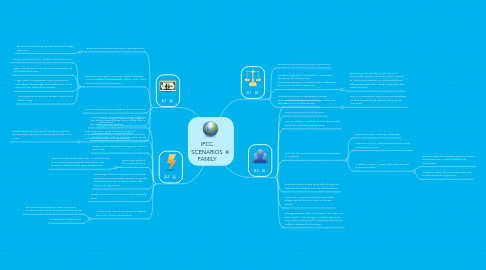
1. A1
1.1. Rapid and successful economic development
1.1.1. Enhance productivity growth and technology diffusion.
1.2. Regional average income per capita converge - current distinctions between "poor" and "rich" countries eventually dissolve.
1.2.1. Strong commitment to market-based solutions.
1.2.2. High savings and commitment to education at the household level.
1.2.3. High rates of investment and innovation in education, technology, and institutions at the national and international levels.
1.2.4. International mobility of people, ideas, and technology
1.3. National policies on immigration and education
1.4. Communication technology, plays a central role.
1.5. High economic growth leads to shifts of economic power from traditional core countries to the current economic "periphery".
1.5.1. Global population grows to some nine billion by 2050 and declines to about seven billion by 2100.
2. A2
2.1. People, ideas, and capital are less mobile so that technology diffuses more slowly than in the other scenario families.
2.2. Industry adjusts to local resource endowments, culture, and education levels.
2.3. Regions with abundant energy and mineral resources.
2.4. Social and political structures diversify.
2.4.1. Agricultural productivity in the A2 world is one of the main focus areas for innovation and research, development, and deployment.
2.5. Initial high levels of soil erosion and water pollution are eventually eased through the local development of more sustainable high-yield agriculture.
2.6. Global environmental concerns are relatively weak.
2.7. World could have many positive aspects from the current perspective.
2.7.1. The increasing tendency toward cultural pluralism with mutual acceptance of diversity.
2.7.2. Fundamental differences.
3. B1
3.1. Economic development in B1 is balanced
3.2. Invests a large part of its gains in improved efficiency of resource use ("dematerialization"), equity, social institutions, and environmental protection.
3.2.1. Environmental quality is high, as most potentially negative environmental aspects of rapid development are anticipated and effectively dealt with locally, nationally, and internationally..
3.3. Smooth transition to alternative energy systems as conventional oil and gas resources decline.
3.3.1. Use of conventional and unconventional gas as the cleanest fossil resource during the transition.
4. B2
4.1. Concern for environmental and social sustainability.
4.2. Trend toward local self-reliance .
4.3. Human welfare, equality, and environmental protection all have high priority.
4.4. Includes futures that can be seen as positive or negative.
4.4.1. Kinsman (1990): "Caring Autonomy
4.4.2. Wilkerson (1995): values shared within small competing groups.
4.4.3. "Middle Course" (1998): with slow removal of trade barriers.
4.4.3.1. Positive side, this storyline appears to be consistent with current institutional frameworks.
4.4.3.2. Negative side is the relatively slow rate of development in general.
